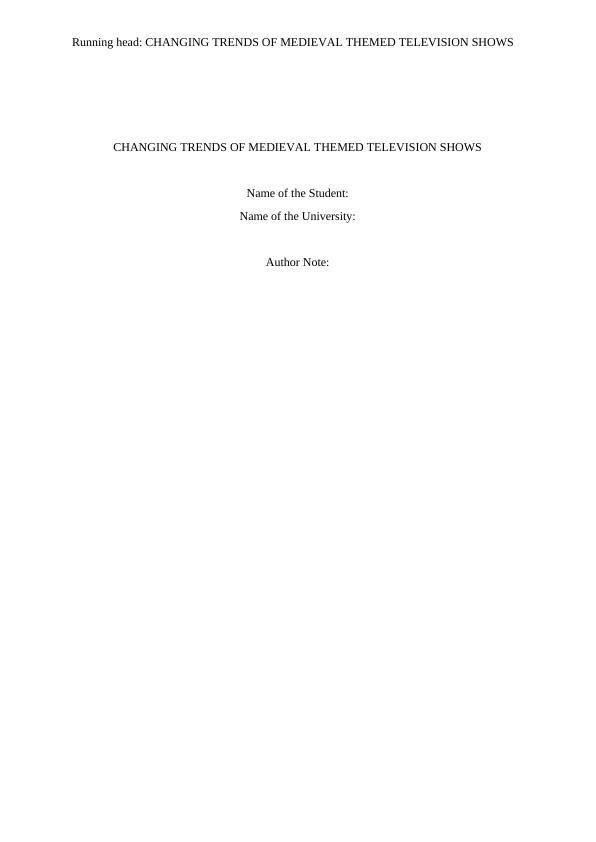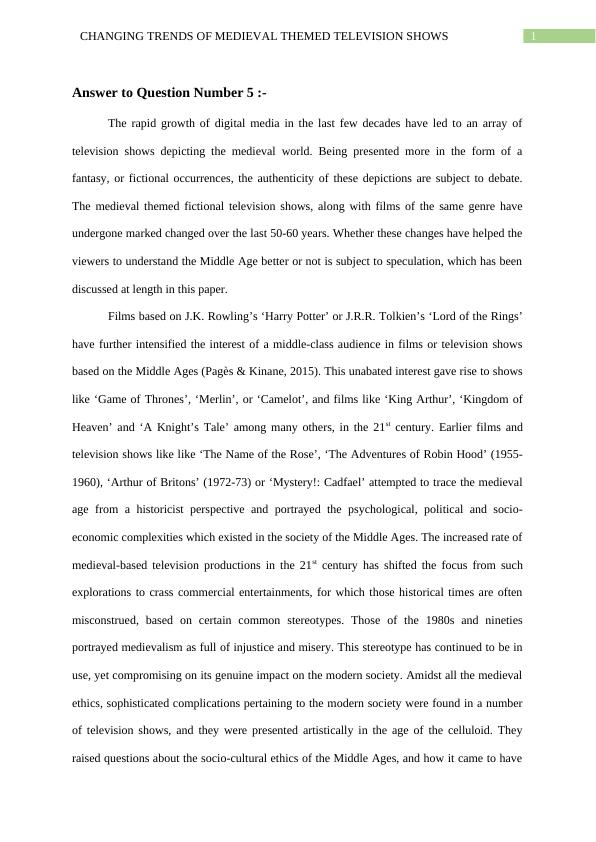Changing Trends of Medieval Themed Television Shows
Added on 2023-06-10
6 Pages1630 Words316 Views
Running head: CHANGING TRENDS OF MEDIEVAL THEMED TELEVISION SHOWS
CHANGING TRENDS OF MEDIEVAL THEMED TELEVISION SHOWS
Name of the Student:
Name of the University:
Author Note:
CHANGING TRENDS OF MEDIEVAL THEMED TELEVISION SHOWS
Name of the Student:
Name of the University:
Author Note:

1CHANGING TRENDS OF MEDIEVAL THEMED TELEVISION SHOWS
Answer to Question Number 5 :-
The rapid growth of digital media in the last few decades have led to an array of
television shows depicting the medieval world. Being presented more in the form of a
fantasy, or fictional occurrences, the authenticity of these depictions are subject to debate.
The medieval themed fictional television shows, along with films of the same genre have
undergone marked changed over the last 50-60 years. Whether these changes have helped the
viewers to understand the Middle Age better or not is subject to speculation, which has been
discussed at length in this paper.
Films based on J.K. Rowling’s ‘Harry Potter’ or J.R.R. Tolkien’s ‘Lord of the Rings’
have further intensified the interest of a middle-class audience in films or television shows
based on the Middle Ages (Pagès & Kinane, 2015). This unabated interest gave rise to shows
like ‘Game of Thrones’, ‘Merlin’, or ‘Camelot’, and films like ‘King Arthur’, ‘Kingdom of
Heaven’ and ‘A Knight’s Tale’ among many others, in the 21st century. Earlier films and
television shows like like ‘The Name of the Rose’, ‘The Adventures of Robin Hood’ (1955-
1960), ‘Arthur of Britons’ (1972-73) or ‘Mystery!: Cadfael’ attempted to trace the medieval
age from a historicist perspective and portrayed the psychological, political and socio-
economic complexities which existed in the society of the Middle Ages. The increased rate of
medieval-based television productions in the 21st century has shifted the focus from such
explorations to crass commercial entertainments, for which those historical times are often
misconstrued, based on certain common stereotypes. Those of the 1980s and nineties
portrayed medievalism as full of injustice and misery. This stereotype has continued to be in
use, yet compromising on its genuine impact on the modern society. Amidst all the medieval
ethics, sophisticated complications pertaining to the modern society were found in a number
of television shows, and they were presented artistically in the age of the celluloid. They
raised questions about the socio-cultural ethics of the Middle Ages, and how it came to have
Answer to Question Number 5 :-
The rapid growth of digital media in the last few decades have led to an array of
television shows depicting the medieval world. Being presented more in the form of a
fantasy, or fictional occurrences, the authenticity of these depictions are subject to debate.
The medieval themed fictional television shows, along with films of the same genre have
undergone marked changed over the last 50-60 years. Whether these changes have helped the
viewers to understand the Middle Age better or not is subject to speculation, which has been
discussed at length in this paper.
Films based on J.K. Rowling’s ‘Harry Potter’ or J.R.R. Tolkien’s ‘Lord of the Rings’
have further intensified the interest of a middle-class audience in films or television shows
based on the Middle Ages (Pagès & Kinane, 2015). This unabated interest gave rise to shows
like ‘Game of Thrones’, ‘Merlin’, or ‘Camelot’, and films like ‘King Arthur’, ‘Kingdom of
Heaven’ and ‘A Knight’s Tale’ among many others, in the 21st century. Earlier films and
television shows like like ‘The Name of the Rose’, ‘The Adventures of Robin Hood’ (1955-
1960), ‘Arthur of Britons’ (1972-73) or ‘Mystery!: Cadfael’ attempted to trace the medieval
age from a historicist perspective and portrayed the psychological, political and socio-
economic complexities which existed in the society of the Middle Ages. The increased rate of
medieval-based television productions in the 21st century has shifted the focus from such
explorations to crass commercial entertainments, for which those historical times are often
misconstrued, based on certain common stereotypes. Those of the 1980s and nineties
portrayed medievalism as full of injustice and misery. This stereotype has continued to be in
use, yet compromising on its genuine impact on the modern society. Amidst all the medieval
ethics, sophisticated complications pertaining to the modern society were found in a number
of television shows, and they were presented artistically in the age of the celluloid. They
raised questions about the socio-cultural ethics of the Middle Ages, and how it came to have

2CHANGING TRENDS OF MEDIEVAL THEMED TELEVISION SHOWS
a significant bearing on the contemporary age. The cliché of narrow-minded brutality of the
Middle Ages in ‘The Name of the Rose’ gained popularity not because of its accurate
portrayal of that time, but it questioned the evolution and progress of humankind as a whole.
Allegations against modern television shows based on medieval times may be called
erroneously harsh in this regard, because the line of action for television strictly follows a
capitalistic path, where there would be a continuous bombardment of popular images, notions
and archetypes which would entice the audience to buy the products (Pagès & Kinane, 2015).
The role of ideology in shaping the course of creativity, authentic representation and accurate
understanding of the age is therefore intertwined with consumerism, in case of these visual
products. The cast is often decided, based on the marketability of the characters through those
actors. Kit Harrington portraying the character of a typical good-looking, brave and
chivalrous Jon Snow in ‘Game of Thrones’ can be a case in point (Uckelman, Murphey, &
Percer, 2017). It immediately establishes a connection between the programme and the
viewers. Director Brian Helgeland has deliberately introduced modern elements like music
and fashion in ‘A Knight’s Tale’ with the intention of bringing the medieval age close to the
modern audience. He used of authentic elements like the name Ulrich von Liechtenstein, and
there was a medieval author by that name who had existed. However, the amalgamation made
it more difficult to understand the medieval age, rather than making it easier. The
serialization and domesticity of the modern television, with complexities specific to a modern
psychology, make the shows all the more appealing and comfortable for the viewers. Thus,
without getting judged in their private zones, their emotions are being played with
uninhibitedly, with pretentious yet productive and market-friendly items.
This consumerist attitude in the portrayal of middle ages in television shows were
however, not present in the earlier ages. They were more driven by the intention of learning,
both from the perspective of their makers as well as the viewers. This shift in focus, which
a significant bearing on the contemporary age. The cliché of narrow-minded brutality of the
Middle Ages in ‘The Name of the Rose’ gained popularity not because of its accurate
portrayal of that time, but it questioned the evolution and progress of humankind as a whole.
Allegations against modern television shows based on medieval times may be called
erroneously harsh in this regard, because the line of action for television strictly follows a
capitalistic path, where there would be a continuous bombardment of popular images, notions
and archetypes which would entice the audience to buy the products (Pagès & Kinane, 2015).
The role of ideology in shaping the course of creativity, authentic representation and accurate
understanding of the age is therefore intertwined with consumerism, in case of these visual
products. The cast is often decided, based on the marketability of the characters through those
actors. Kit Harrington portraying the character of a typical good-looking, brave and
chivalrous Jon Snow in ‘Game of Thrones’ can be a case in point (Uckelman, Murphey, &
Percer, 2017). It immediately establishes a connection between the programme and the
viewers. Director Brian Helgeland has deliberately introduced modern elements like music
and fashion in ‘A Knight’s Tale’ with the intention of bringing the medieval age close to the
modern audience. He used of authentic elements like the name Ulrich von Liechtenstein, and
there was a medieval author by that name who had existed. However, the amalgamation made
it more difficult to understand the medieval age, rather than making it easier. The
serialization and domesticity of the modern television, with complexities specific to a modern
psychology, make the shows all the more appealing and comfortable for the viewers. Thus,
without getting judged in their private zones, their emotions are being played with
uninhibitedly, with pretentious yet productive and market-friendly items.
This consumerist attitude in the portrayal of middle ages in television shows were
however, not present in the earlier ages. They were more driven by the intention of learning,
both from the perspective of their makers as well as the viewers. This shift in focus, which

End of preview
Want to access all the pages? Upload your documents or become a member.
Related Documents
The Middle Ages in the Modern Worldlg...
|6
|1237
|200
Analysis and Report on English Movielg...
|15
|3562
|31
